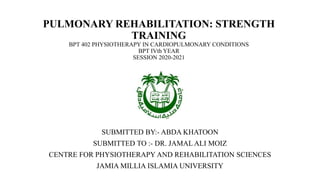
Pulmonary rehabilitation strength training
- 1. PULMONARY REHABILITATION: STRENGTH TRAINING BPT 402 PHYSIOTHERAPY IN CARDIOPULMONARY CONDITIONS BPT IVth YEAR SESSION 2020-2021 SUBMITTED BY:- ABDA KHATOON SUBMITTED TO :- DR. JAMAL ALI MOIZ CENTRE FOR PHYSIOTHERAPY AND REHABILITATION SCIENCES JAMIA MILLIA ISLAMIA UNIVERSITY
- 2. INTRODUCTION • The American Thoracic Society(ATS) and the European Respiratory Society (ERS) have adopted the following new definition of pulmonary rehabilitation: • “Pulmonary rehabilitation is a comprehensive intervention based on a thorough patient assessment followed by patient tailored therapies that include, but are not limited to, exercise training, education, and behavior change, designed to improve the physical and psychological condition of people with chronic respiratory disease and to promote the long-term adherence to health-enhancing behaviors.” • Pulmonary rehab may be initiated at any stage of the disease, during periods of clinical stability or during or directly after an exacerbation.
- 3. Contd.. The goals of pulmonary rehabilitation include • Minimizing symptom burden, • Maximizing exercise performance, • Promoting autonomy, • Increasing participation in everyday activities, • Enhancing (health-related)quality of life, and • Effecting long-term health-enhancing behavior change.
- 4. AIMS OF PULMONARY REHABILITATION The aims of pulmonary rehabilitation are: • To maximize independent functioning in activities of daily living and minimize dependence on significant others and community agencies. • To evaluate and initiate, as appropriate, physical training to increase exercise tolerance and encourage efficient energy expenditure. • To provide educational sessions for patients,families and significant others regarding disease processes, medication and therapeutic techniques.
- 5. BENEFITS OF PULMONARY REHABILITATION • An improved quality of life • A reduction of anxiety and depression • Improved exercise tolerance • Reduction in breathlessness and other • Associated symptoms • An enhanced ability to perform activities of daily living. Traditionally improvements in rehabilitation have been measured by changes in exercise capacity; however, more recently the measurement of quality of life has become increasingly important.
- 6. Criteria for entry to a pulmonary rehabilitation program Psychological/practical • Motivated to embark on self-help • Motivated to make lifestyle changes • Can hear or communicate adequately in a group setting • Personality suitable for group work • Able to attend for required period Medical • Shortness of breath and reduction of activity causing concern • Stable and on optimum medication Exclusions • Patients with progressive diseases, e.g. cancer or neuromuscular disease • Patients with conditions where exercise is contraindicated, e.g. certain cardiac disorders
- 7. Preliminary assessment for pulmonary rehabilitation • Past medical history • Smoking history • Medication • Spirometry (FEV/FVC) • Blood gas analysis/resting oxygen saturation/heart rate • Perceived breathlessness • Quality of life (general/disease specific) • Exercise tolerance • Previous hospital admissions • Height/weight (to calculate BMI)
- 8. Strength training • Exercise training in pulmonary rehabilitation should encompass both upper and lower extremity endurance training, strength training and respiratory muscle training. • Duration, frequency, mode and intensity of exercise should be included in the patient’s individualized exercise prescription, based on disease severity, degree of conditioning, functional evaluation and initial exercise test data. • Peripheral muscle dysfunction and muscle weakness are highly prevalent comorbidities of COPD, contributing to exercise intolerance. • It is assumed that resistance training can reverse peripheral muscle dysfunction and thereby reduce the burden of COPD impairment. • Resistance training as an adjunct to endurance is recommended in all patients especially those with peripheral muscle weakness. • Because strength training has a greater potential to improve muscle mass and strength than endurance training, a combination of these two exercise modalities is highly recommended
- 9. Benefits of Strength training • Strength training also provokes less dyspnoea during exercise, which most probably makes it easier to tolerate than aerobic training • Therefore, a combination of resistance training with interval endurance training can be a useful alternative training strategy in patients severely restricted in their ability to perform endurance training due to marked ventilatory limitation • the effects of strength training may also be translated into meaningful changes in functional performance such as climbing stairs, standing up or arm elevation activities . • An easy and very practical approach to determine optimal resistance for strength training is that the physiotherapist sets a training load so the patient is able to repeat an exercise six to maximally 12 times and has to stop due to muscle fatigue. • With a little experience from the physiotherapist this is a very quick and useful approach that does not necessarily require determining the 1RM. • When the subject can perform the current workload for one or two repetitions over the desired number of six to 12 repetitions on two consecutive training sessions it is recommended to apply a 2–10% increase in load
- 10. Recommendations for the implementation of strength training • Objective:- Targeting for local muscular exhaustion within a given number of repetitions for major muscle groups of upper and lower extremities. • Mode :- two to four sets of six to twelve repetitions. • Frequency :- 2- 3 times per day • Intensity :- 50 -85% of one RM as a reference point. Increase work load by 2-10% if one to two repetition over the desired number are possible on two consecutive training session. • Time:- 20-30 minutes • Type :- Free weights, resistance band etc. • Speed :- moderate (1-2 sec concentric and 1-2 sec eccentric) • Typical muscles targeted are the biceps, triceps, deltoids, latissimus dorsi, and the pectorals.
- 11. References • An Official American Thoracic Society/European Respiratory Society Statement: Key Concepts and Advances in Pulmonary Rehabilitation, Martijn A. Spruit et al, 2013 • Jennifer A. Pryor, Barbara A. Webber, 2001, physiotherapy for cardiac and pulmonary problem, 2nd edition, Churchill livingstone